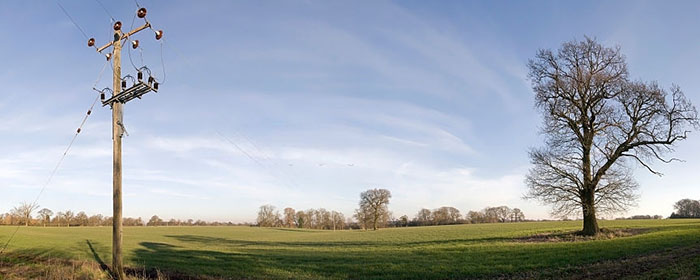
Utility Poles (also referred to as transmission poles, telegraph posts, telephone poles, power poles, hydro poles, and telecommunications poles) are posts used by utility companies to support cables and other equipment required for the operation of public services.
Table of Contents
What is a Utility Pole?
A utility pole is an upright column used to provide support to public utility and services apparatus such as power lines, cables, and wires. They are also sometimes used to accommodate other relevant equipment such as road appliances (e.g. traffic lights), as well as decorations for events and public holidays.
Utility poles are an efficient way of keeping awkward or hazardous equipment where it has the least chance of being disturbed. The overhead suspension also helps to provide a more reliable means of signal transmission for computers, phones, and other telecommunication devices.
A single utility pole may be used for multiple purposes. Depending on requirements and the available resources utility poles vary in both size and the material used to make them. An average pole is around 12 metres (40ft) in height, and (depending on the terrain) spaced anywhere between 38 – 91 metres (125-300ft) apart.
Types of Utility Poles used in Overhead Lines
The utility poles used to accommodate overhead lines can be divided by two main criteria: a) pole material; and b) transmission type.
a) Pole material
The most common three materials used to make utility poles are wood, concrete, and steel. In selecting the best material a range of factors need to be considered, including the location, voltage load, and installation and maintenance costs.
1.Wooden Utility Poles
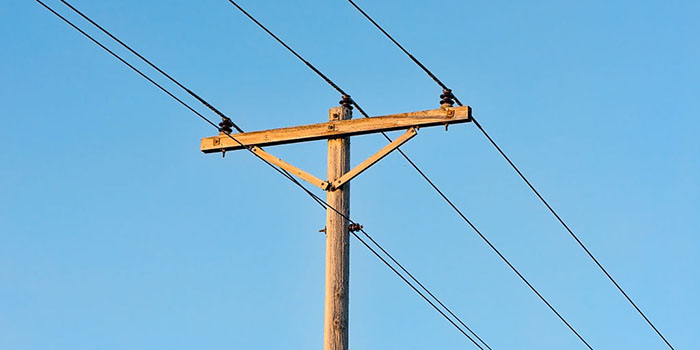
Cheap and widely available, wood has historically been a popular choice for line poles, with pine, cedar, and fir varieties especially favoured due to their height and durability. Wooden poles must be ‘seasoned’ (dried out) before use to enable them to tolerate more moisture absorption in wet weather conditions.
Wooden poles also need to be treated with a preservative to minimise the risk of fungi, rot, and the damage caused by wildlife. In modern times there has been a shift away from creosote towards the use of more environmentally-friendly preservatives, such as Pentachlorophenol and Copper Zinc Arsenate.
Poles crafted from wood have a limited voltage capacity and run a fire risk if exposed to extreme heat. In addition, they require regular maintenance to ensure that they are not rotting or otherwise deteriorating (e.g. due to woodpecker damage).
Seasoned wooden utility poles have an average lifespan of 25-50 years. Their eventual deterioration usually results from rot below ground level.
2. Steel Utility Poles
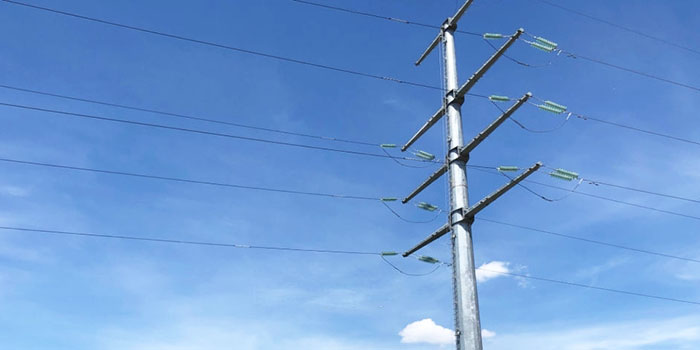
As a more durable, environmentally-friendly option with a higher loading capacity, steel is often used as an alternative to wood. Because it can be melted down and reformed, steel also offers flexibility with pole length – enabling taller poles suited to higher voltage loads to be made.
Poles crafted from steel are also relatively reliable and easy to install – making them the ideal choice in densely populated towns and cities.
Steel utility poles are of two main types:
- Stepped poles (ISTPs): Poles made with built-in maintenance steps (useful for road signs); and
- Swaged poles (ISWPs): Poles specially shaped for extra strength (useful for street lighting).
For the heavier duty projects covering a wider area, large steel towers are used in place of poles. Steel electricity towers can transport anywhere up to 300,000 volts.
However, steel poles are more expensive to manufacture and can be prone to rust. As there is also a risk of electrocution if a live wire comes into contact with the pole, more robust safety features are necessary for their use.
Correctly installed and maintained, steel line poles last an average of 60 years. Galvanization helps to maximise their life expectancy.
3. Concrete Utility Poles
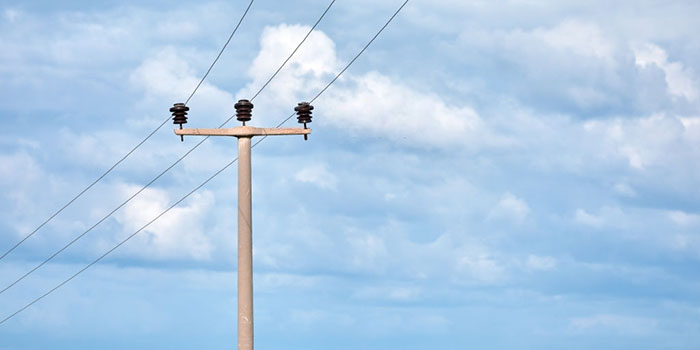
Concrete utility poles possess the highest load capacity out of the three. Like steel, they are extremely resistant to rot and wildlife damage, require minimal maintenance, and weather well in harsh climatic conditions. The insulating properties of concrete are also similar to those of wooden poles.
The two main types of concrete poles used to accommodate overhead lines are reinforced concrete (useful for weight and stability), and prestressed concrete (useful for strength and lateral capacity).
The main disadvantages of concrete poles are that if not made on-site, the cost of transporting them is considerable. In addition, concrete poles also cannot be easily modified, are heavy and awkward, and can pose a safety risk if they weaken.
Spun-cast concrete poles have a lifespan of 50 years or more. Their heaviness and relative impenetrability make them the ideal choice for use in coastal areas, where they can weather sea air, harsh winds, and boggy ground well.
b) By application/ transmission
Utility poles are mainly used for three different kinds of overhead lines: 1. Transmission lines; 2. Distribution lines; and 3. Public service lines.
The utility poles used to support these are transmission poles, distribution poles, and light poles:
- Transmission Poles transport primary, high voltage power (230KV or more for towers) between power stations. Transmission poles and towers are often made of metal, and anchored to the ground with concrete;
- Distribution Poles transmit secondary, lower voltage power (5-33KV) directly to businesses and homes. The power carried by these lines has already been processed and converted to an appropriate level (known as a ‘service drop’) for ordinary, everyday usage; and
- Light Poles are used to transmit varied levels of power to the range of fixtures used in public services, such as traffic equipment, CCTV, and street lighting. These kinds of utility poles are normally self-supporting.
Distribution poles can be tangent, guyed, or self-supporting. Tangent poles are basic purpose poles arranged in a straight line. Guyed distribution poles are those which have an in-built guy wire as an additional means of support, and self-supporting poles are those which are unable to depend on any additional support (e.g. those which house an awkward space).
Sub-transmission and distribution lines are often carried by different sets of utility poles. However, it can be cost and space-effective to accommodate both on the same poles. This is achieved via an ‘under build’, whereby distribution lines are incorporated onto transmission line poles.
What is on an Electric Power Pole?
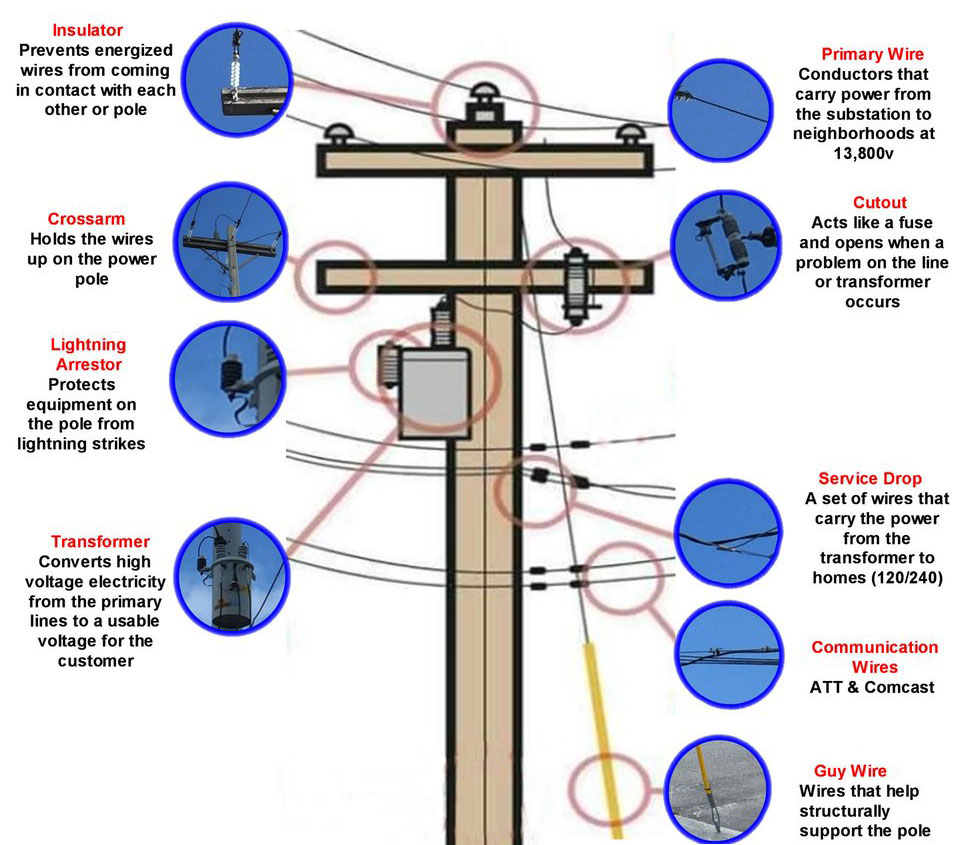
The main features of an electric power pole can be divided into 3 categories: a) Wires and cables; b) Hardware; and c) Safety features.
1. Wires & Cables
Utility power poles often accommodate numerous cables and wires. The main groups of lines on electrical poles are:
- Static Lines: This includes a static wire (used to divert lightning surges), and a neutral line or multi-grounded neutral (MGN) which provides a return path for the electrical current;
- Transmission Lines: These can be further divided into primary lines, which carry the highest voltage, and secondary lines, carrying power which has already undergone a service drop;
- Telecommunication Lines: e.g. those for telephone and internet connection;
- Guy Lines: Those which connect the pole to the foundational level.
2. Utility Pole Hardware
Hardware is the term used to describe the various pieces of equipment which are essential in ensuring the efficient functioning of power poles, such as bolts, hooks, pole clamps, fittings, nuts, washers, cross arms, and assemblies.
Pole hardware has many important purposes, including (but not limited to):
- Providing structural and safety support to the pole;
- Assisting with power conversion and transmission;
- Facilitating guying and wiring requirements.
Wooden poles can be pre-drilled to accommodate hardware parts fairly easily. Steel poles can be manufactured with built-in grooves for the same purpose; on-site drilling is also an option, as is the welding of parts.
However, for poles crafted from concrete drilling is not an option. Hardware can only be cast into the pole during its manufacture – not an easy process.
Because the drilling, welding, and casting of steel and concrete poles can be expensive, time-consuming, and/or hazardous, externally banded hardware has become a more popular method for attaching hardware to utility poles.
3. Safety Features
Utility poles incorporate numerous safety features designed to prevent a range of dangerous occurrences. Some of the most common safety features on power poles include:
- Static wire: runs across the very top. It helps to shield the pole from lightning damage by absorbing any excess electrical current resulting from a lightning strike;
- Grounding rods: A wire connects the static wire to a grounding rod at the foundation, which channels any lightning-induced voltage safely into the earth;
- Transformers: Convert raw, high voltage electricity into levels that are safe for regular everyday use;
- Fuse cut-outs: Accommodate the primary wire from the transformer, and act as a visual ‘warning signal’ if the transformer becomes overloaded;
- Insulators: Protect live components from coming into contact with each other (aerial bundled conductors also help to prevent wildfires using a similar method).
How to Install a Utility Pole?
Once the utility pole is made and adapted as desired, it needs to be installed. This requires the assistance of specialist machinery.
The basic installation steps are:
- Transportation: If not made at the location the pole needs to be brought on-site;
- Digging the hole: A minimum depth of 1/3 of the pole length for maximum stability;
- Grounding: The pole needs to be grounded with copper to drain excess voltage;
- Positioning: The pole needs to be correctly positioned and then lifted;
- Insertion: Once optimal, the pole can then be eased into the hole;
- Securing: The hole is filled and leveled, securing the pole in place.
A video for utility pole installation:
Final Thoughts
From the telegraph to the telephone, to our modern internet era: our ability to share information has been revolutionised. A process once taking days has been streamlined into a second, reinventing our ability to connect with one other on both a personal and professional level.
For nearly 180 years, the humble utility poles speckling our streets and supporting our systems have been the force literally underpinning this progress. With their aid, the developments in telecommunication technology have been able to continue to enhance and expand our lives, keeping us connected across boundaries of time and space.
Utility poles have helped us to create a world of infinite global possibilities – and will continue to do so for many years to come.
Frequently asked questions (FAQ)
What is a utility pole?
A utility pole is an upright column used to provide support to public utility and services apparatus such as power lines, cables, and wires.
Types of utility poles used in overhead lines
The utility poles used to accommodate overhead lines can be divided by two main criteria: pole material and transmission type.
- According to Pole materials, there are 3 types: wooden utility poles, steel utility poles and concrete utility poles.
- According to applications, there are also 3 types: transmission poles, distribution poles and light poles.
What is on an electric power pole?
The main features of an electric power pole can be divided into 3 categories: Wires and cables, Hardware, and Safety features.
- Utility power poles often accommodate numerous cables and wires, such as static lines, transmission Lines, telecommunication Lines.
- Hardware is the term used to describe the various pieces of equipment which are essential in ensuring the efficient functioning of power poles, such as bolts, hooks, clamps, fittings, nuts, washers, and assemblies.
- Utility poles incorporate numerous safety features designed to prevent a range of dangerous occurrences, such as grounding rods, transformers, fuse cut-outs and insulators.
How to install a utility pole?
The basic installation steps are:
- Transportation: If not made at the location the pole needs to be brought on-site;
- Digging the hole: A minimum depth of 1/3 of the pole length for maximum stability;
- Grounding: The pole needs to be grounded with copper to drain excess voltage;
- Positioning: The pole needs to be correctly positioned and then lifted;
- Insertion: Once optimal, the pole can then be eased into the hole;
- Securing: The hole is filled and leveled, securing the pole in place.